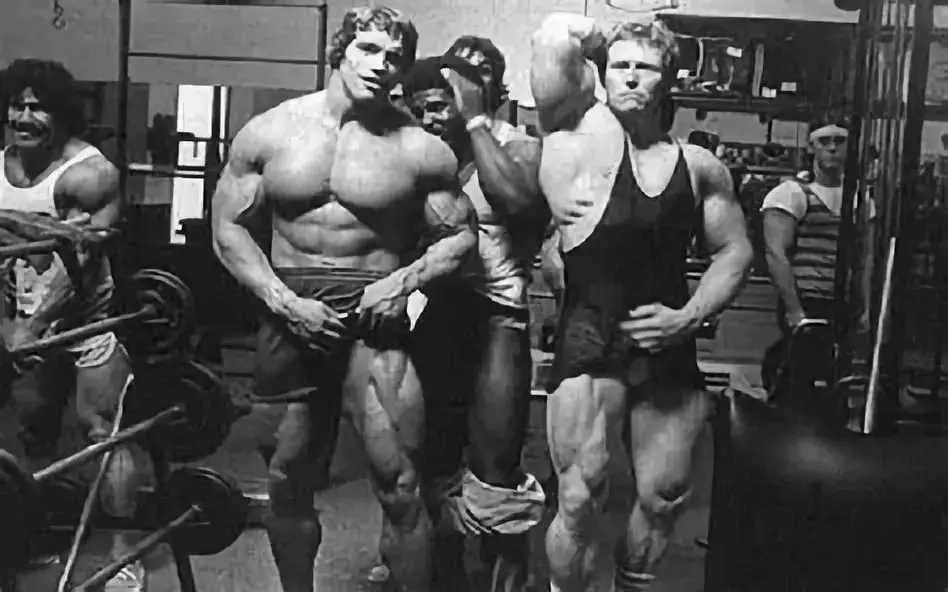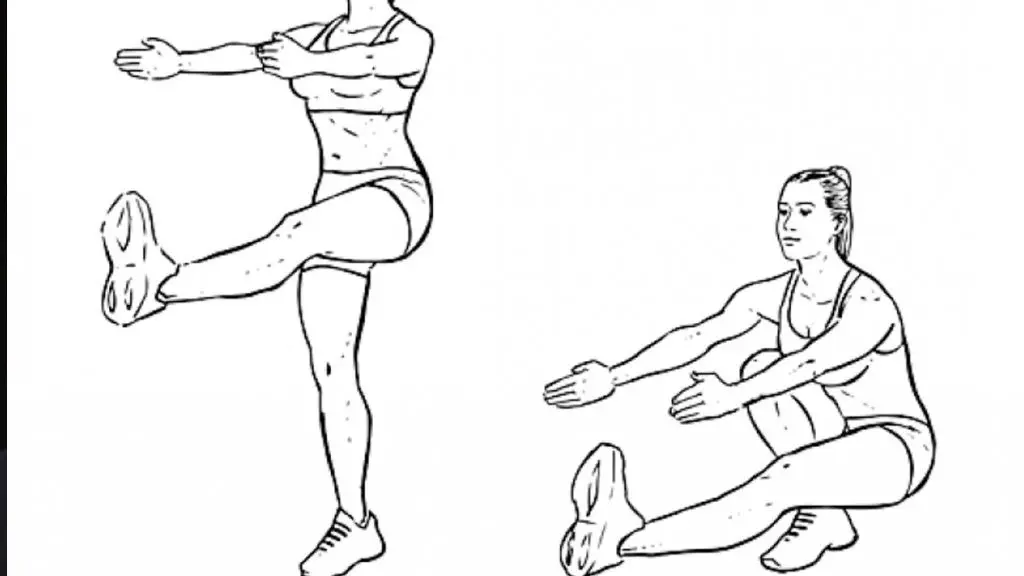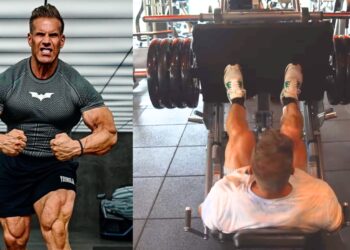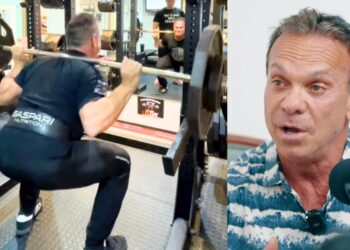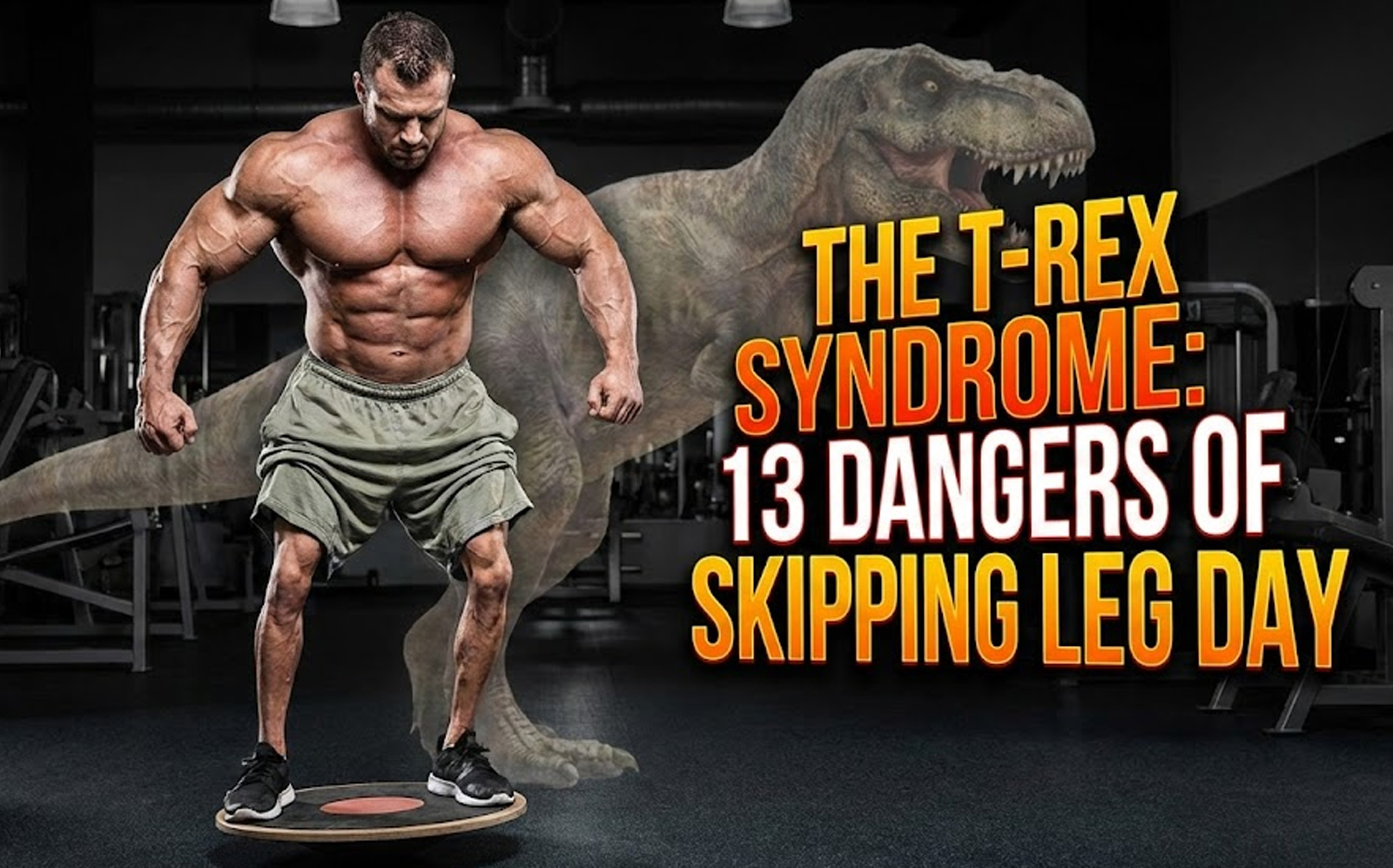The quadriceps might be the most difficult muscle to build at home, with little to no access to training equipment. After all, there’s only so much you can do to ensure consistent overload that’ll result in progressive muscle growth and strength.
As a personal trainer with over five years of experience coaching at-home clients, I’ve shortlisted exercises and workouts that effectively build and maintain muscle through targeted volume, adaptable technique, and modifiable intensity.
In this article, I reveal the 13 best quad exercises you can do at home with zero equipment to build muscular thighs and an impressive lower body.
Recent Updates: On July 23, 2024, Fitness Volt’s Content Strategist Tom Miller (CSCS) and Senior Editor Vidur Saini (American Council on Exercise-CPT) updated the article and added actionable expert tips throughout the piece to improve the reader experience.
Level Up Your Fitness: Join our 💪 strong community in Fitness Volt Newsletter. Get daily inspiration, expert-backed workouts, nutrition tips, the latest in strength sports, and the support you need to reach your goals. Subscribe for free!
13 Best Quadriceps Exercises You Can Do At Home
The following exercises range from simple to challenging in no particular order (although, I’ve specified their level of difficulty). Some exercises certainly aren’t for everyone (also noted for ones that apply). But I think most people can benefit from them beyond just maintaining and building muscle/strength.
Many of the exercises below are unilateral (affecting one side), which means they’re good for identifying and correcting imbalances. Not to mention, if your goal is to improve your athletic performance, you should be doing these movements even if you have all the equipment in the world. (1)
Alright, let’s get to it…
- Single-Leg Squat
- Levitation Squat
- Bulgarian Split Squat
- Jump Squat
- Lunge
- Reverse Lunge
- Lateral Lunge
- Step-Up
- Bodyweight Leg Extension
- Cossack Squat
- Skater Jump
- Single-Leg Squat To Box
- Sissy Squat
1. Single-leg squat
| Sets & Reps | Equipment Needed | Target Muscles |
| 3 x 5-8 | None | Quadriceps, glutes, hamstrings, core |
First, there is a superior exercise (single-leg squat) that is a must if you want to maximize leg development using only your bodyweight. It allows for much more overload than a basic, two-legged squat. And it does require balance if you choose not to do an assisted variation. This is totally fine and optimal for improving balance and stabilization.
However, if you don’t want to worry about balancing, you can lightly grip a sturdy object for assistance. This is also better for squatting through the heel (better for the knees) since you can place your working leg out a little further forward if you hold onto something.
Saini highlights that the pistol squat is the ultimate test of single-leg strength and balance. Mastering it improves athleticism and decreases the risk of injury in everyday activities.
To do it:
- Keep your body straight and core tight.
- Squat down with one leg until your upper leg is parallel or slightly lower while lifting the other leg in front of you.
Lightly grip a door frame or something similar to help you better balance yourself. But don’t pull up as you don’t want to use your upper body. You can also use a TRX, rope, or something similar by wrapping it around something high (e.g. tree branch, door) for balance.
Pro Tip: As you lower down, actively drive your non-working leg forward and up to help maintain balance and engage your core.
| Difficulty | Progression | Regression |
| Advanced | Hold a weight for added resistance, lower deeper | Assisted pistol squat (use a TRX or band for support) |
2. Levitation squat
| Sets & Reps | Equipment Needed | Target Muscles |
| 3 x 10-15 | None | Quadriceps, glutes, core |
The levitation squat is a variation of the single-leg squat. Except, it’s much easier to balance without having to hold onto anything. Therefore, it’s also much better for improving unilateral development, balance, and stabilization.
“This isometric hold builds incredible quad endurance and mind-muscle connection,” says Saini. Think of it as meditation for your thighs.
To do it:
- While standing, bend one leg and maintain your balance by holding your arms out.
- Squat down until your bent knee reaches a few inches from the ground or it touches.
- Stand back up and repeat for reps then switch to the other leg, alternating for sets.
Pro Tip: Engage your glutes and quads isometrically while holding the bottom position to maximize muscle activation and time under tension.
| Difficulty | Progression | Regression |
| Intermediate | Add pulses at the bottom | Decrease hold time |
3. Bulgarian split squat
| Sets & Reps | Equipment Needed | Target Muscles |
| 3 x 8-12 | Elevated surface (chair, bench) | Quadriceps, glutes, hamstrings, core |
Saini adds that this exercise is a powerhouse for building strength and hypertrophy and is a must-have in any leg day routine.
The Bulgarian split squat is a great movement for isolating one leg. It’s also one of the single-leg exercises we recommend loading up with extra weight when/if and if you do have access to free weights. We also suggest practicing this exercise with no extra weight at first since it requires balance.
If you have a hard time balancing at first, have something next to you for light assistance.
- Stand facing away from a chair, bench, or any similar platform/object.
- Place the top of one foot on the object and move the other leg out a few feet in front of you but try to keep your shin vertical.
- Squat down until your upper leg is parallel or slightly below and then drive back up through your heel.
- Complete your reps and then repeat with the other leg.
Pro Tip: Lean slightly forward from your hips to shift more of the load onto your front quad. This will increase intensity and challenge your balance.
| Difficulty | Progression | Regression |
| Intermediate | Elevate front foot, add weight (dumbbell, backpack) | Conventional split squat |
4. Jump squat
| Sets & Reps | Equipment Needed | Target Muscles |
| 3 x 10-15 | None | Quadriceps, glutes, hamstrings, calves |
The jump squat is perfect for building lower body explosiveness and power. If you participate in athletic activities, this movement will greatly benefit you.
Jump squats not only build explosive power but also enhance cardiovascular fitness, explains Saini. They’re a full-body exercise disguised as a leg movement.
To do it:
- Squat down to parallel or just above while bringing your arms down by your sides.
- Explode through your midfoot and leap into the air while bringing your arms up.
- Landly softly by bending your knees to absorb the impact.
Pro Tip: Focus on a quick and powerful concentric phase, using your arms to generate momentum. Absorb the landing softly to protect your joints.
| Difficulty | Progression | Regression |
| Beginner | Increase jump height, add a box jump element | Squat without the jump |
5. Lunge
| Sets & Reps | Equipment Needed | Target Muscles |
| 3 x 10-12 | None | Quadriceps, glutes, hamstrings |
The lunge is probably the most optimal single-leg lower-body exercise that allows you to maintain balance while doing it. That’s because both feet are on the floor. It develops the entire leg and is especially effective for training the glutes or butt.
Saini underlines that the lunge is a fundamental movement pattern that mimics walking and running. Strengthening the lunge pattern improves gait efficiency and reduces lower body strain.
There are so many great variations of the lunge, and this is the most basic.
To do it:
- Stand with feet about shoulder-width distance apart.
- Step forward with one leg until it’s bent at a 90-degree angle or slightly lower.
- Drive up through your heel until you’re back in the starting position and repeat with the other leg.
- Alternate legs until you’ve completed the desired number of reps.
Pro Tip: Keep your front knee tracking over your second toe throughout the entire movement to prevent knee strain and ensure proper quadriceps engagement.

| Difficulty | Progression | Regression |
| Beginner | Increase stride length, add weight (backpack) | Shorten stride length |
6. Rear lunge
| Sets & Reps | Equipment Needed | Target Muscles |
| 3 x 10-12 | None | Quadriceps, glutes, hamstrings |
The rear lunge is an ideal variation that’s better on the knees than the basic variation above. That’s because it better allows you to keep your shins vertical. But don’t worry, it still works the same muscles.
Reverse lunges place less stress on the knees than forward lunges, making them a great option for those with knee sensitivities, suggests Saini.
To do it:
- With feet together, step one leg back behind your body and bend the front leg at a 90-degree angle or slightly lower. Keep your shin vertical.
- Push up through the heel of the front leg back into the starting position and repeat with the other leg.
Pro Tip: Think about reaching back with your rear leg rather than ‘stepping’ back. This will help maintain balance and prevent your front knee from traveling too far forward. Level Up Your Fitness: Join our 💪 strong community in Fitness Volt Newsletter. Get daily inspiration, expert-backed workouts, nutrition tips, the latest in strength sports, and the support you need to reach your goals. Subscribe for free!
| Difficulty | Progression | Regression |
| Beginner | Position the front foot on an elevated surface | Split squats |
7. Lateral lunge
| Sets & Reps | Equipment Needed | Target Muscles |
| 3 x 10-12 | None | Quadriceps, glutes, hip adductors |
We do a lot of exercises that work on the anterior (front) and posterior (back) of the body. But if you’re not doing a type of lateral movement then you’re not training to be well-rounded and developed. Imbalances lead to energy leaks and we’re not able to execute certain movements at the highest possible level.
Saini highlights that lateral lunges target the often-underworked hip adductors, which are crucial for hip stability and athletic performance.
- Stand with your feet together.
- Step out wide and to the side (laterally) and squat down with that leg keeping your shin as vertical as possible. Keep the weight back on your back.
- Return to the starting position and then repeat with the other leg.
Pro Tip: Push through the heel of your planted foot to return to the starting position. This will activate your glutes and hamstrings, enhancing the exercise’s effectiveness.
| Difficulty | Progression | Regression |
| Beginner | Tempo reps | Touch down for balance |
8. Step-up
| Sets & Reps | Equipment Needed | Target Muscles |
| 3 x 10-15 | Elevated surface (stairs, box) | Quadriceps, glutes, hamstrings |
It truly doesn’t get much easier than the step-up. It’s kind of like a squat variation so you work the quads, glutes, hamstrings, and even core. It’s also a very good exercise for those with less than perfect knees because you can step up with a vertical shin. Therefore, you won’t have as much force at the knee if done properly.
Step-ups are a functional exercise that strengthens the muscles used for climbing stairs and hiking, says Saini. They also improve balance and coordination.
To do it:
- Stand in front of an object/platform that is a few feet high.
- Step up onto the end of the platform and use your quads to drive your foot through and lift your body up. Make sure your knee doesn’t move far forward over your foot.
- Step down and repeat with the other leg.
Pro Tip: Drive through the heel of your lead foot to lift your body onto the step. Avoid pushing off with your trailing leg to maximize quad activation.
| Difficulty | Progression | Regression |
| Beginner | Tempo reps | Lunges |
9. Bodyweight leg extension
| Sets & Reps | Equipment Needed | Target Muscles |
| 3 x 15-20 | None | Quadriceps |
Don’t have a leg extension machine? That’s not a problem for most people. This variation involves using your upper body as the resistance while your thighs work to extend. This exercise is not for everyone due to the stress at the knee, and you might want to use it sparingly either way.
This isolation exercise is a great way to finish off your quads and pump them up at the end of a workout, recommends Saini.
To do it:
- Sit on the floor in a tall kneeling position (lower legs on the floor).
- Lean your torso back and then use your quads to push yourself back into the starting position.
Pro Tip: I recommend warming up your knees with some bodyweight squats before doing these. Also, you can lean back only halfway to prevent too much stress on the knees. You may have to experiment a little with this movement to get it just right.
| Difficulty | Progression | Regression |
| Beginner | Slow down the eccentric phase | Use hands for support, decrease range of motion |
10. Cossack squat
| Sets & Reps | Equipment Needed | Target Muscles |
| 3 x 8-12 | None | Quadriceps, glutes, adductors, hamstrings |
An interesting leg variation, the Cossack squat is similar to a lateral lunge but there are definitely some differences. It’s a very good option for getting a nice, full range of motion in the squat position.
The cossack squat is a unique movement that challenges your mobility and stability in all three planes of motion, says Saini. It’s a true test of hip and ankle flexibility.
Pro Tip: Keep your torso upright and your heel planted on the ground throughout the movement. This will prevent excessive stress on your knee and maximize the stretch in your groin and adductors.
| Difficulty | Progression | Regression |
| Intermediate | Increase depth, add weight (hold a jug of water) | Use a wall for support |
Read: Cossack squat exercise guide
11. Skater Jump
| Sets & Reps | Equipment Needed | Target Muscles |
| 3 x 10-15 | None | Quadriceps, glutes, hamstrings, calves |
You can probably visualize a skater’s technique as they move. Well, the skater jump is going to look very similar because, well, that’s where it gets the name. There is some impact with this exercise so make sure your ankles are in good shape before doing it.
Saini adds that skater jumps are a plyometric exercise that builds explosive power and agility. They’re great for athletes who rely on lateral quickness.
To do it:
- Hinge forward slightly at the hips.
- Jump side to side, squatting down during each jump, and bring the other leg behind the landing foot.
Pro Tip: Take small steps if you’re new to this exercise. Perfect the jump before taking bigger leaps for the safety of your knees and ankles.
| Difficulty | Progression | Regression |
| Beginner | Increase distance of lateral jump, add a hop | Lateral step instead of jump |
12. Single-leg squat to box
| Sets & Reps | Equipment Needed | Target Muscles |
| 3 x 5-8 | Box or sturdy platform | Quadriceps, glutes, hamstrings, core |
This variation is similar to the basic single-leg squat. Except you’ll sit on a platform or object about the height of a box or chair. It’s a really effective exercise for building concentric quad strength, and it makes the exercise more challenging, which means more overload and more muscle growth potential.
“This exercise is a great stepping stone towards the pistol squat,” highlights Saini.
To do it:
- With your core tight and torso straight, lift the non-working leg and squat down until you’re seated. Place your arms out in front of you for optimal balance and assistance.
- Drive through your midfoot until standing.
- Complete your ideal number of reps then repeat with the other leg.
Pro Tip: Control the eccentric phase of the movement, aiming for a three-second descent to increase time under tension (TUT) and maximize muscle growth.
| Difficulty | Progression | Regression |
| Advanced | Use a smaller box, hold a weight for added resistance | Conventional squat |
13. Sissy squat
| Sets & Reps | Equipment Needed | Target Muscles |
| 3 x 10-15 | Wall or sturdy object | Quadriceps |
The sissy squat is very effective for overloading the quads. The only possible drawback is that it can be rather tough on the knees similar to the leg extension. You can do this exercise by holding onto something or freestanding.
Saini says that the sissy squat is an old-school exercise that uniquely targets the quads and is a great way to add variety to your quad training and challenge your mobility.
To do it:
- Hold onto something high for support or do it freestanding.
- Tighten your core and keep your body straight with feet about shoulder-width.
- Bend your knees and lean back then push your feet through the floor to return to the starting position.
Pro Tip: Beginners should avoid bending too deep to ensure optimal knee health. Start with half of the typical range of motion and then gradually increase. Warm-up by doing some light cardio and bodyweight squat before doing these.
| Difficulty | Progression | Regression |
| Intermediate | Increase range of motion, hold for longer at the bottom. | Decrease range of motion, use a wall closer for support. |
Best Quad-Focused Workout For Building Bigger Legs
This workout focuses on a variety of movement patterns and difficulty levels for overall development:
| Exercise | Sets | Reps | Rest |
| Jump Squat | 3 | 10-15 | 30 sec |
| Bulgarian Split Squat | 3 | 8-12/leg | 60 sec |
| Reverse Lunge | 3 | 10-12/leg | 60 sec |
| Lateral Lunge | 3 | 10-12/leg | 60 sec |
| Bodyweight Leg Extension | 3 | 15-20 | 30 sec |
Quads Anatomy
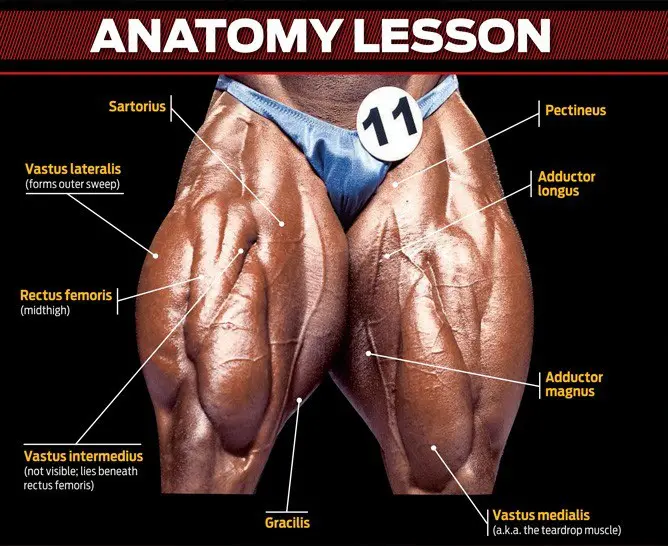
The quadriceps or quads are located on the anterior of the upper leg. It consists of four muscles (hence the name) which include the rectus femoris, vastus lateralis, vastus medialis, and vastus intermedius.
All four muscles act to extend the knee, while only the rectus femoris inserts and functions at the hip. The quads also play a big role in walking, proper posture, and maintaining patellar stability.
When developed, the quads contribute to the bulk of the upper leg and total lower body strength.
Frequently Asked Questions (FAQs)
Is it possible to build big legs using bodyweight only?
You can build lots of muscle in your legs from just bodyweight exercises alone. However, there comes a point when the resistance is not enough to support continued hypertrophy and maximal development.
You can certainly be creative and utilize different techniques to create additional overload though. But it honestly depends on how “big” we’re talking here.
What are the most effective bodyweight quad exercises?
Your best options will be those that utilize one leg at a time and ones that are difficult for you to complete a repetition of, due to having to overcome a relatively challenging load.
So, any exercise that is difficult for you and when performed in a proper manner is going to be the most effective.
A few examples include:
- Single-leg squats
- Lateral lunge
- Bodyweight leg extension
- Single-leg squat to box
- Sissy squat
- Cossack squat
Are bodyweight leg exercises safer than weighted exercises?
There may always be the chance that bodyweight exercises pose less of an injury risk simply because using a lot of additional weight is not natural on the joints and muscles.
However, bodyweight-only exercises offer something that weighted exercises do not and the fact that these movements are very important for overall development means they need to be treated with caution as well.
Sometimes people think just because bodyweight exercises don’t require weights, they can do a lot at first. This simply isn’t true and can lead to injury from overuse and improper form.
Start small and gradually increase your movement. This will ensure you have a better chance at remaining injury-free.
Will it take longer to build muscular legs using bodyweight exercises?
This depends on your experience level, intensity, volume, and exercise selection. If you’ve reached a more advanced level in your training, then most likely bodyweight exercises will result in slower progress.
This is because you’re not able to apply as much overload which is essential for growth at the fastest rate possible.
Wrapping up
That’s quite the list of superior quad exercises, don’t you think? If you’re not already doing these movements on leg days, then you have plenty of great options here. Just make sure to warm up properly and not too much, too fast.
Start small, even if you’re used to training hard on leg day at the gym because bodyweight movements offer something unique. Therefore, you should treat them as such. If you progress with these movements, add some weight by loading up a bag, pack, or anything else that’ll make these exercises more challenging.

